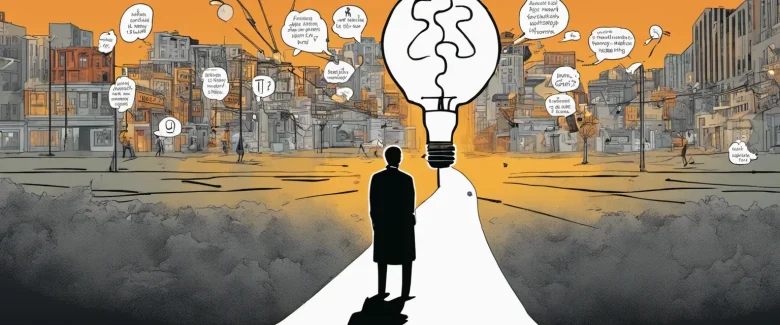In his thought-provoking book Antifragile, renowned scholar and risk analyst Nassim Nicholas Taleb explores the concept of embracing uncertainty and volatility as means to thrive and grow. Drawing from his extensive knowledge of mathematics, philosophy, economics, and history, Taleb presents a groundbreaking approach to understanding and navigating an unpredictable world. By introducing the concept of antifragility, he challenges conventional wisdom and provides valuable insights into how to better adapt and flourish amidst chaos.
Chapter 1: Introduction to Antifragility
Chapter 1: Introduction to Antifragility of the book Antifragile by Nassim Nicholas Taleb lays the foundation for the concept of antifragility and its significance in various fields. Taleb begins by distinguishing between fragile, robust, and antifragile systems. Fragile systems are vulnerable to shocks and suffer irreparable damage when faced with unexpected events. Robust systems, on the other hand, can withstand shocks without adverse effects, but they do not necessarily benefit from them either. Antifragile systems, as the name suggests, not only survive but thrive in the face of volatility and uncertainty.
Taleb highlights the limitations of conventional risk management strategies and argues that uncertainty is an inherent part of life. He posits that societies and individuals should strive to become antifragile in order to effectively navigate unpredictable events, rather than attempting to eliminate all risks.
Next, the author explores the notion of asymmetry, explaining how gains and losses are not equal in magnitude. While individuals should strive to minimize the extent of potential losses, they should also actively seek out opportunities that have the potential for significant upside gains. This asymmetry is crucial in determining the robustness or fragility of a system.
Taleb then delves into the concept of randomness and emphasizes its role in shaping events and systems. While humans have an innate desire to find patterns and explanations for random events, the author argues that such attempts are often flawed and misleading. Instead, he advocates for embracing randomness and leveraging it to gain an antifragile advantage.
In conclusion, Chapter 1 sets the stage for understanding the importance of antifragility in adapting, succeeding, and flourishing in an unpredictable world. Taleb challenges conventional wisdom, urging readers to embrace volatility and capitalize on asymmetries to create a resilient and thriving existence.
Chapter 2: Nonlinearity and Randomness
Chapter 2 of “Antifragile” by Nassim Nicholas Taleb explores the concepts of nonlinearity and randomness and their effects on systems, particularly those that exhibit antifragility.
Taleb starts by highlighting the difference between linearity and nonlinearity. Linear systems have predictable outcomes, meaning that doubling the input will double the output. However, most real-world systems are nonlinear, where the relationship between input and output is not proportionate. Nonlinearity introduces a level of complexity and unpredictability into these systems. Taleb argues that understanding nonlinearity is essential for navigating uncertainty and building systems that can benefit from disorder.
Randomness is another crucial aspect discussed in this chapter. Taleb explains that randomness often emerges from nonlinear systems, leading to unpredictable events and unforeseen consequences. He introduces the concept of the “Black Swan,” which represents a rare and highly impactful event that takes people by surprise. These Black Swan events challenge our linear thinking and can have a profound impact on complex systems.
Taleb emphasizes that nonlinear systems often have positive and negative effects. While some shocks can be detrimental, others may help improve the system’s resilience and adaptability. This is the essence of antifragility—the ability of a system to benefit and grow stronger in the face of randomness and shocks. Taleb also highlights that antifragile systems are more resilient than just being robust, as they not only withstand disruptions but actually thrive from them.
In this chapter, Taleb lays the groundwork for understanding the principles of antifragility by introducing the concepts of nonlinearity and randomness. These concepts form the basis for his exploration of how to build more robust and adaptable systems that can benefit from uncertainty.
Chapter 3: Fragility and Its Causes
Chapter 3 of “Antifragile” by Nassim Nicholas Taleb focuses on the concept of fragility and its causes. Taleb defines fragility as the vulnerability to harm or disruption, particularly when exposed to volatility, uncertainty, and randomness in the world. He argues that fragility is not the opposite of resilience or robustness, but rather a distinct property that requires its own understanding.
Taleb introduces the notion of “signal to noise” ratio, which refers to the amount of meaningful information compared to irrelevant or misleading data. Higher levels of fragility are associated with a lower signal to noise ratio, as it becomes difficult to distinguish between useful and useless information. Fragile systems tend to rely heavily on prediction and assume stability, making them susceptible to shocks and failures.
He criticizes the modern focus on efficiency, which often leads to over-optimization and increased dependence on specific variables or models. This results in systems that are highly exposed to risks and susceptible to rare events. Taleb emphasizes the need for redundancy, optionality, and decentralized decision-making to reduce fragility and enhance adaptability in the face of uncertainty.
Furthermore, Taleb examines the role of modernity in creating artificial fragility, particularly through an overreliance on technology and complex systems. He argues that technological innovations can both create and amplify fragility, causing severe consequences when they fail or become disrupted.
In summary, Chapter 3 of “Antifragile” explores the concept of fragility and its causes. It highlights the importance of understanding fragility as a distinct property, as well as the need for redundancy, optionality, and decentralized decision-making to reduce vulnerability and adapt to uncertainty. Taleb warns against the dangers of over-optimization and reliance on technology, which can artificially create or amplify fragility in systems.
Chapter 4: The Barbell Strategy

Chapter 4 of “Antifragile” by Nassim Nicholas Taleb explores the concept of the Barbell Strategy, which is a risk management approach that emphasizes extremes rather than the middle ground.
Taleb explains that people often adopt a strategy of risk aversion, where they make small, incremental investments across various areas, hoping to accumulate small gains over time. However, he argues that this strategy is flawed because it exposes individuals to hidden risks and prevents them from benefiting from positive shocks. In contrast, the Barbell Strategy involves placing the majority of one’s resources in extremely safe, low-risk investments, while simultaneously allocating a small percentage to high-risk, potentially high-reward investments.
The idea behind the Barbell Strategy is to protect oneself from the downside while being exposed to favorable Black Swan events, which are rare and unpredictable occurrences that can have a significant positive impact. By avoiding moderate, mediocre investments and focusing on extremes, one becomes more resilient to unexpected shocks and can benefit from serendipitous events. Furthermore, this approach allows individuals to learn from small, frequent losses rather than experiencing a catastrophic loss that could be devastating.
Taleb provides several examples of the Barbell Strategy, such as investing the majority of one’s portfolio in Treasury bills and dedicating a small portion to highly speculative bets in entrepreneurial ventures or options. He also discusses how this strategy can be applied in other areas of life, such as decision-making, relationships, and personal development.
Overall, the Barbell Strategy is an unconventional but effective approach to risk management, enabling individuals to navigate uncertainty and capitalize on unexpected opportunities.
Chapter 5: Optionality and Convexity
In Chapter 5 of “Antifragile” by Nassim Nicholas Taleb, the author delves into the concepts of optionality and convexity and their relevance in achieving antifragility.
Optionality refers to the ability to have the upside potential without having to bear the corresponding downside risks. Taleb argues that the world is full of opportunities where you can benefit from positive events without being harmed by negative ones – these options increase your overall resilience. He emphasizes the importance of recognizing and actively seeking out such opportunities, as they can provide immense advantages in an uncertain world.
Convexity, on the other hand, is the property of benefitting from uncertainty, volatility, and variability. Taleb emphasizes that it is not about reducing risk, but rather exploiting it. He explains how the nonlinear nature of convexity allows one to gain more from positive events than what is lost from negative events, resulting in a net gain. Understanding convexity can help individuals and systems become antifragile by not only surviving but thriving in the face of uncertainty and shocks.
Taleb uses various examples to illustrate these concepts, such as his involvement in the financial markets, where he made profits from asymmetric outcomes and optionality. He also examines the impact of optionality and convexity in domains like medicine, entrepreneurship, and personal decision-making.
In sum, Chapter 5 explores the significance of optionality and convexity in building antifragility. The ability to benefit from positive events while minimizing downside risks and leveraging uncertainty can offer a strategic advantage in navigating a complex and unpredictable world.
Chapter 6: Stressors, Volatility, and Disorder
Chapter 6 of Antifragile by Nassim Nicholas Taleb, titled “Stressors, Volatility, and Disorder,” focuses on the concept of antifragility in a complex and unpredictable world. Taleb begins by emphasizing the importance of stressors, or random shocks and uncertainties, in fostering growth and resilience.
He argues that both systems and individuals need exposure to stressors to develop and thrive. A certain degree of volatility is essential for adaptation and improvement. Taleb introduces the idea of hormesis, which refers to the positive impact of small doses of stressors on overall well-being and strength.
Taleb discusses how hidden risks and vulnerabilities can quickly magnify and lead to catastrophic events. He stresses the need to embrace disorder and volatility by building systems that are robust to randomness and can withstand shocks. He gives examples from various fields, such as finance, medicine, and engineering, to demonstrate the fragility of overly optimized and delicate systems.
Furthermore, Taleb emphasizes the importance of having skin in the game, meaning that individuals or institutions should experience the consequences of their actions. This principle aligns with antifragility, as it ensures better decision-making and accountability.
The chapter also delves into the concept of optionality, highlighting the benefits of having multiple options in uncertain times. Optionality provides flexibility, allowing individuals or organizations to adapt and take advantage of unexpected opportunities.
In summary, Chapter 6 of Antifragile stresses the need for exposure to stressors and volatility as a means to develop resilience and antifragility. The author emphasizes the potential dangers of fragile systems and advocates for embracing disorder as a source of growth. Taleb provides a comprehensive understanding of the importance of stressors, optionality, and having skin in the game in navigating an unpredictable world.
Chapter 7: Decision-Making and Heuristics
Chapter 7 of “Antifragile” by Nassim Nicholas Taleb focuses on decision-making and heuristics. Taleb argues that decision-making is a critical aspect of life, and our ability to make good decisions is heavily influenced by the heuristics we use.
Taleb introduces the concept of heuristics, which are mental shortcuts or rules of thumb that we employ to simplify decision-making processes. While heuristics can be efficient in many situations, they can also lead to biases and errors in judgement. Taleb emphasizes the need to understand and recognize these biases to make more robust decisions.
He highlights the importance of “via negativa,” a heuristic that emphasizes removing negatives rather than adding positives. According to Taleb, it is often easier to identify what is harmful or unnecessary and eliminate it, rather than trying to find the perfect positive solution. Applying this approach allows individuals and systems to become more antifragile in the face of uncertainty and unexpected events.
Taleb also introduces the concept of “lindy,” which is a heuristic that suggests the expected future lifespan of something is proportional to its past lifespan. This idea can be applied to decision-making by considering the track record and history of a particular action or principle. If something has proven to be robust and successful over a long period, it is more likely to continue being so in the future.
Additionally, Taleb discusses the importance of embracing uncertainty and probabilistic thinking in decision-making. He argues that we should not rely solely on deterministic models or predictions but rather make decisions based on a range of possibilities and their associated probabilities.
In summary, Chapter 7 of “Antifragile” explores the role of heuristics in decision-making and emphasizes the need to understand and overcome biases. It advocates for the use of via negativa, recognizing the history of outcomes, and embracing uncertainty to make more robust decisions.

Chapter 8: Antifragile Systems in Business and Politics
Chapter 8: Antifragile Systems in Business and Politics of the book Antifragile by Nassim Nicholas Taleb discusses the importance of embracing and building antifragile systems in the realms of business and politics. The chapter argues that these systems not only withstand unexpected shocks but actually benefit from them.
Taleb begins by explaining the concept of the “barbell strategy” which involves investing a majority of resources in low-risk, stable assets while keeping a small portion in highly uncertain, high-reward investments. This approach protects against extreme losses while giving the potential for significant gains. He emphasizes that an antifragile system should be highly resilient and adaptable, capable of thriving in the face of uncertainty and volatility.
In the business context, Taleb criticizes large corporations that he refers to as “big, dumb, fragile” entities, highlighting their vulnerability to unexpected events and their inability to quickly respond to changing circumstances. He argues that small, agile businesses are more likely to be antifragile, with the ability to adapt, learn, and grow from any unforeseen challenges.
Regarding politics, Taleb criticizes centralized, top-down decision-making processes that ignore the local knowledge and wisdom of individuals and communities. He advocates for a decentralized system where decision-making power is distributed, fostering competition and experimentation rather than relying on a single authority.
Taleb also highlights the importance of optionality in both business and politics. Optionality refers to having a range of choices or alternatives available, allowing for flexibility and adaptability. He argues that having multiple options is crucial for navigating complex and unpredictable systems effectively.
Overall, this chapter emphasizes the necessity of embracing antifragility in both business and politics, advocating for a more decentralized, adaptable, and resilient approach to maximize the potential for long-term success.
After Reading
In conclusion, “Antifragile” by Nassim Nicholas Taleb is a thought-provoking exploration of how individuals, systems, and societies can thrive and grow stronger in the face of uncertainty and unpredictability. Taleb introduces the concept of antifragility, which refers to entities that not only withstand shocks and disturbances but actually benefit from them. Through various examples and anecdotes, the author emphasizes the importance of embracing randomness and volatility rather than trying to eliminate or control them. He also highlights the limitations and risks of fragility, arguing that our obsession with stability and control can ultimately make us more vulnerable to sudden disruptions. Additionally, Taleb provides practical advice on how to navigate an uncertain world, advocating for a decentralized and adaptable approach that allows for continuous learning, experimentation, and adaptation. Overall, “Antifragile” invites readers to challenge conventional wisdom and reevaluate their views on risk, resilience, and success in order to prosper in a complex and rapidly changing environment.
1. Only The Paranoid Survive” by Andrew Grove
In this captivating book, Andrew Grove, the former CEO of Intel, provides invaluable insights into managing in today’s rapidly changing business world. Grove challenges conventional thinking by emphasizing the importance of constant adaptation and agility. Drawing upon his own experiences, he offers practical strategies to navigate through uncertainty and turn adversity into opportunity. This book is a must-read for entrepreneurs, executives, and anyone seeking to thrive in a hyper-competitive landscape.
2. The Smartest Guys in the Room” by Bethany McLean
Bethany McLean, an investigative journalist, dissects one of the most notorious corporate failures in history: Enron. Through meticulous research and interviews, she unravels the complex web of deceit and greed that led to Enron’s collapse. McLean’s storytelling prowess makes this non-fiction book read like a thrilling novel, shedding light on the dangerous culture of corporate arrogance and the devastating consequences of unethical practices. For those interested in corporate governance and understanding how power can corrupt, “The Smartest Guys in the Room” is a captivating choice.
3. The Hard Thing About Hard Things” by Ben Horowitz
Ben Horowitz, a successful entrepreneur and venture capitalist, shares his experiences and hard-won lessons in this candid and practical guide. Horowitz delves into the challenges faced by startup founders and CEOs, walking readers through the gritty realities of building and managing a company. With sincerity and humor, he offers essential advice on confronting tough decisions, leading during crisis, and cultivating a winning culture. This book is a go-to resource for aspiring and seasoned entrepreneurs alike.
4. Thinking, Fast and Slow” by Daniel Kahneman
If you’ve just finished “Antifragile” and have developed a fascination for understanding the human mind, “Thinking, Fast and Slow” is a brilliant follow-up choice. Daniel Kahneman, a Nobel laureate in economics, explores the two systems that drive our thinking: the intuitive, quick-thinking system, and the deliberate, logical system. Through a blend of research and captivating anecdotes, Kahneman exposes the systematic cognitive biases that influence our decision-making. This thought-provoking book provides profound insights into human behavior, decision-making, and the illusions of our own minds.
5. Zero to One” by Peter Thiel
Peter Thiel, co-founder of PayPal and an influential venture capitalist, challenges conventional wisdom about innovation and disruption in “Zero to One.” Drawing from his successful entrepreneurial journey, Thiel encourages readers to think critically and build companies that create completely new value rather than copying existing ideas. His thought-provoking and contrarian perspectives will push you to re-evaluate your assumptions about business and uncover unique opportunities for growth. “Zero to One” is an inspiring book for aspiring entrepreneurs and those interested in fostering groundbreaking ideas.



